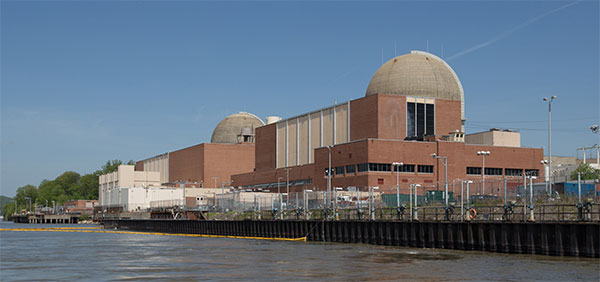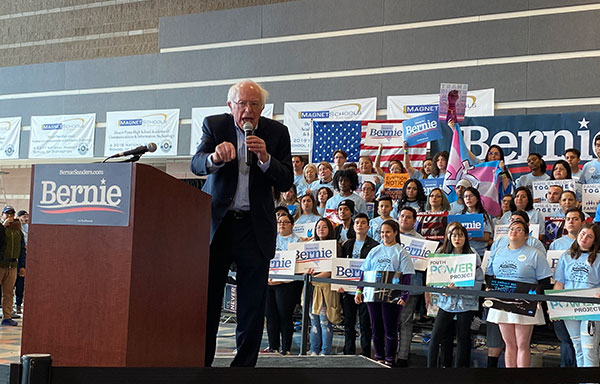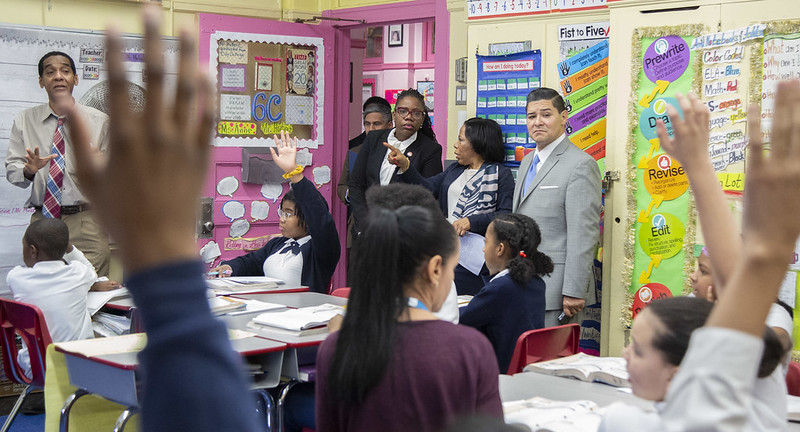Is Cuomo Serious About Addressing Climate Change? Indian Point Decision Says No

Indian Point (photo: the governor's office)
Governor Andrew Cuomo claims that New York is a leader in addressing the dangers of climate change. So far, the facts fail to support this.
Since 2010, New York’s gas-fired and dual-use (gas & oil) electric capacity has increased over four times as fast as wind plus other sources of renewable power. Fossil fuels today produce eight times as much electricity as all our renewables, exclusive of hydropower. This movement towards greater fossil fuel use is about to get far worse if the carbon-free Indian Point nuclear plant is shut down and replaced by natural gas.
The Climate Leadership and Community Protection Act (CLCPA), signed by the governor in July, commits New York to eliminate the burning of fossil fuels for electricity by 2040. Tragically, long before 2040, all the hoped-for benefits of the CLCPA will be negated. In just a few weeks, Unit 2 of the Indian Point nuclear power plant in Westchester is scheduled to shut down, to be replaced by gas-fired power that will release 3.5 million metric tons of carbon dioxide into the atmosphere each year.
Next year Unit 3 will shut down, adding a similar amount of greenhouse gases to the atmosphere each year thereafter. At that rate, the “world’s largest off-shore wind farm” that the governor hopes to build off of Long Island will not show any net environmental benefit for at least 20 years. We can’t wait that long to deal with climate change.
Further, in spite of CLCPA declarations and over the objections of many citizens, the Cuomo administration recently approved an increase in electric rates to enable Con Edison to expand its use of natural gas. Earlier, the state authorized the construction and operation of several new natural gas-burning plants, including a very large gas plant in Dutchess County due to open in May.
Most inexplicably and disastrously, the Cuomo administration has agreed to shut down the Indian Point plant in Westchester County. Its safe and reliable power is the largest clean source of electricity in the downstate region, providing fully 80% of our carbon-free power. Indian Point’s closure will set back New York’s climate plans for decades. What is going on here?
In many parts of the country, nuclear plants, the nation’s major source of carbon-free power, are threatened with closure by competition from lower-cost natural gas. Here in New York, nuclear power provides 32% of our electricity and over half our carbon-free energy (hydropower supplies most of the rest). The governor supports subsidizing upstate nuclear plants that provide clean energy, jobs, and tax revenue, but he has refused to provide similar support for the Indian Point plant, even though it supplies 25% of the Metro region’s electricity as well as many jobs and local tax revenue. It appears that he has been misled by fear-mongering false claims like the need for massive evacuations and other myths. The scientific community has debunked all these myths, but state leadership is unmoved.
When the governor announced the closure agreement, he told the people of New York that replacement power would add no new carbon to the atmosphere. This commitment will not be met if Indian Point is replaced by gas. Worse, present gas pipeline and power plant limitations may require that the dirtiest gas plants in New York City are pressed into service. Many of these polluting plants are located in low-income environmental justice areas. Pollutants that worsen asthma and other ailments will assail the residents of these communities.
Achieving a low-carbon future will require vast increases in clean electricity production, and all renewable sources are challenged. Hydropower cannot be expanded very much at all. Land-based wind power accounts for just 3% of the state’s electricity output today, and no new wind installations are currently under construction.
Even with the planned expansion of New York’s transmission system, only limited amounts of upstate wind power can be brought to the downstate region. The planned off-shore wind farm will just begin to bring some electricity to New York City by 2028, if it proceeds on schedule. However, this enormous project will have to be accompanied by giant banks of storage batteries if it is to supply reliable electricity to the Metro area when the wind isn’t blowing.
Solar energy provides just 1.6% of the state’s electric output today. The state government’s climate plan requires that solar energy produce more than 30% of our electric output by 2030, but at the current rate at which solar panels are being installed, this goal won’t be reached for 100 years. A recent comprehensive report from the Citizens Budget Commission, an influential think tank, found that the projected expansion of solar and wind was “likely infeasible.” It seems clear that the state lacks a workable plan to provide the growing amount of carbon-free electricity we will need to address the climate crisis.
Nuclear energy has shown, over the last 60 years, that it can provide large quantities of safe and reliable electric power. Its costs are high, but advanced designs and more efficient manufacturing methods can bring these down. These advanced designs are capable of producing electricity where and when it is needed.
As a start, there is no need to shut down Indian Point. This facility has been running safely and reliably for nearly 50 years, and it could keep going for many more. The governor’s closure agreement wisely allows Unit 2 to continue operating until 2024 and Unit 3 a year longer. Further, major issues have recently arisen with the decommissioning of these plants that will need more time to be sorted out. We should use this closure agreement to its fullest and extend operations four more years.
While the state develops a new, realistic energy plan using all its carbon-free resources, it should not shutter the Indian Point nuclear plant.
***
Leonard Rodberg is a physicist who taught climate change and public policy at Queens College/CUNY until his retirement in 2017. Herschel Specter is an engineer who focused on nuclear safety issues in many positions, including at the Nuclear Regulatory Commission and the International Atomic Energy Agency.
***
Have an op-ed idea or submission for Gotham Gazette? Email This email address is being protected from spambots. You need JavaScript enabled to view it.
Lessons for the New York Primary from Sanders’ Nevada Blowout

Bernie Sanders & Make the Road Action in Nevada (photo: Make The Road)
People across the country were stunned by Bernie Sanders’ 28-point victory in the Nevada caucuses. Not our members. Why? From Make the Road Action’s on-the-ground work mobilizing Latino voters and other voters of color in East Las Vegas, it was clear that the Sanders campaign had overwhelming support in our communities. The Latino vote was his secret weapon.
And looking forward, Sanders’ performance in Nevada, where 30% of the population is Latino, and people of color are the majority of the population, has important implications for future primaries closer to home -- like in New York, where 18% of the state’s population is Latino and people of color make up more than 40% of the population.
Over the past two months, our members in Las Vegas had a front-row seat to observe the Sanders campaign’s dominant ground game in Latino communities and other communities of color. The campaign prioritized hiring a diverse staff with deep community connections, and investing real resources—dollars and staff time, not lip service—into organizing these communities. While other campaigns relied primarily on the airwaves, the Sanders campaign, through a robust precinct-by-precinct outreach strategy and culturally-relevant event series like “Tamales con Tio Bernie,” showed a clear focus on in-person organizing.
The campaign also showed a deep commitment to grassroots partnerships and the synergies they bring. Since early last year, the Sanders campaign engaged community organizations like Make the Road Action and our members, asking for input on policy platforms and organizing strategy.
When our members ultimately chose to endorse Sanders, the campaign also worked to make us an integral part of the campaign. When Senator Sanders held a rally in Las Vegas on the first day of early voting, four of our members spoke first—sharing their experiences of fighting for affordable housing and against unjust immigration policies in Las Vegas. When we marched to an early caucus site right after, Sanders marched with us.
The campaign’s commitment to community partnership yielded concrete results. Our Nevada members were so energized that our team ultimately knocked on 10,000 doors and made more than 30,000 phone calls to engage Latino voters and other voters of color across East Las Vegas. We also reached millions of people nationwide via social media with original, bilingual content highlighting our support for Sanders.
On caucus day, we saw the fruits of that labor. Statewide, entrance polls showed Sanders winning a clear majority of Latino votes—a remarkable feat given that there were 11 names on the ballot. At the dozens of precincts across East Las Vegas that we covered, Sanders won overwhelmingly, with community members reporting to us that they had received visits at their doors from the campaign and from Make the Road Action. When one of our poll-site interpreters asked an older Latina voter for whom she was voting, she went into her purse, pulled out a Make the Road Action flyer, pointed to Sanders' face, and said: "I'm voting for him."
The Nevada results have clear implications for states like New York, with large Latino populations and many voters of color. Here, too, we can already see the strength of the Sanders ground game, with an all-volunteer statewide infrastructure collecting 65,000 petition signatures to get him on the New York ballot.
And, as in Nevada, our black and Latino members in New York, alongside progressive elected officials—like Alexandria Ocasio-Cortez, Jumaane Williams, Jessica Ramos, Julia Salazar, Ron Kim, Mike Gianaris, and others—and partner organizations like Democratic Socialists of America and New York Progressive Action are already energized and organizing for the April primary.
Those efforts have begun to bear fruit, with a new Siena poll this week showing Sanders in the lead in the Empire State for the first time in this contest, and with a solid lead among Latino voters.
With the strongest organizing infrastructure in the primary field and robust community partnerships, the Sanders campaign can count on trusted messengers to deliver votes across diverse communities. As we look to Super Tuesday and then on to New York’s primary in late April, expect that infrastructure to pay off.
***
Lalo Montoya and Deborah Axt are, respectively, the Nevada Political Director and the Co-Executive Director of Make the Road Action. On Twitter: @LaLoMontoya5, @DebAxt & @MaketheRoadAct.
***
Have an op-ed idea or submission for Gotham Gazette? Email This email address is being protected from spambots. You need JavaScript enabled to view it.
Far Too Many Classrooms are Overcrowded, It’s Time for City Leaders to Act

DOE Chancellor Richard Carranza visits a classroom (photo: John McCarten/City Council)
In the Campaign for Fiscal Equity case, the state’s Court of Appeals concluded in 2003 that class sizes were too large in New York City schools to provide our students with their constitutional right to a sound basic education, writing that “[T]ens of thousands of students are placed in overcrowded classrooms… The number of children in these straits is large enough to represent a systemic failure.”
And yet despite this decision, and the fact that when Bill de Blasio promised that, if elected mayor, he would lower class sizes in all grades to far lower levels, class sizes have stagnated during his time in office and remain on average 15-30 percent larger than in the rest of the state. In the early grades, they are substantially larger (by 10 percent) than in 2003 when that CFE decision was issued. More than 325,000 students are in classes of 30 or more this year. Let that number sink in.
The research on the benefits of class size is clear, especially for children in the early grades. Project STAR, a large-scale experiment carried out in Tennessee in the 1980s, showed that those students who were randomly placed in smaller classes in K-3 did better in every single way that could be measured. They earned better grades, better test scores, and were less likely to be held back and less likely to have disciplinary problems.
After they reached high school, they were more likely to graduate on time, head for college and graduate with a STEM degree, and own their own home more than 20 years later.
Though no large-scale experiment of a similar kind has been done on class size in the middle and upper grades, there are many studies that show a strong correlation between smaller classes in these grades and students earning better test scores, exhibiting improved non-cognitive skills, and having higher graduation rates, while controlling for other observable factors.
Most importantly, all these gains that result from smaller classes are twice as large for disadvantaged students and students of color, who make up the majority of kids in the New York City public schools. That is why class size reduction is one of only a handful of reforms proven to narrow the achievement and opportunity gap.
Since Mayor de Blasio took office, test score levels have been flat or declining, as measured on the national exams called the NAEPs, the most reliable assessments. And the gap in results between students of different economic and racial groups has widened.
None of this is particularly surprising of course.
In smaller classes, all students, but especially those who are struggling, have their academic and social-emotional needs better met, are able to receive more feedback from their teachers, and feel like their teachers care about them more. This motivates them to show effort and stay on track. It is the personal, human connection that inspires them to learn.
What’s sad is how many New York City teachers say they don’t even have time to answer all their students’ questions because their classes are too large. As a result, too many students are confused and lose interest, become passive and disengaged, or act out in order to obtain the attention they crave.
This is why New York City teachers overwhelmingly say that class size reduction would be the best way to improve our schools, and why New York City parents put smaller classes among their top priorities every year on Department of Education surveys. Most principals agree – and believe that to be able to provide a quality education, class sizes should be no more than 20 students per class in grades K-3, 23 in grades 4-5, and 24 in all other grades.
Schools Chancellor Richard Carranza is the first DOE Chancellor in many years who, when asked, admits that he realizes how important class size is. As a teacher, he says, he knew that he could reach his students better in a class of 24 than 30. And yet when questioned by the City Council at hearings or by parents at town hall meetings what he intends to do about it, his response is almost exactly the same as previous chancellors who had little or no interest in reducing class size: He will wait until the state provides more Foundation Aid funding and then he will allow principals do what they want with the extra funding. This is not an acceptable answer. Why?
First, New York City students should not have to wait for the state to fully fund Foundation Aid, when hundreds of millions of dollars are being spent by the Department of Education on less effective, unproven programs and other expenses — including a substantial increase in bureaucracy and more standardized testing — and the city continues to enjoy a surplus.
Second, the “Fair Student Funding” system, into which the additional Foundation Aid would flow, incentivizes principals to keep class sizes as large as possible, because their funding is tied to the number of students they enroll.
Lastly, class size reduction won’t happen in any systematic and rational fashion unless the New York City Department of Education has a plan to make it happen, by providing the staff and the space where it’s most needed, as they did when they expanded pre-kindergarten programs.
That’s why we are calling on the Mayor and the City Council to step up to the plate, and allocate $100 million in next year’s budget to be allocated specifically towards class size reduction, starting first in the early grades and in struggling schools.
This amount represents less than .3 percent of DOE’s total budget of $34 billion. It would represent the first step in a necessary process of beginning to provide New York City children with the truly equitable and excellent education they deserve, and which parents and educators have long known is badly needed for our schools to succeed.
***
Leonie Haimson is the Executive Director of Class Size Matters. On Twitter @leoniehaimson.
***
Have an op-ed idea or submission for Gotham Gazette? Email This email address is being protected from spambots. You need JavaScript enabled to view it.




